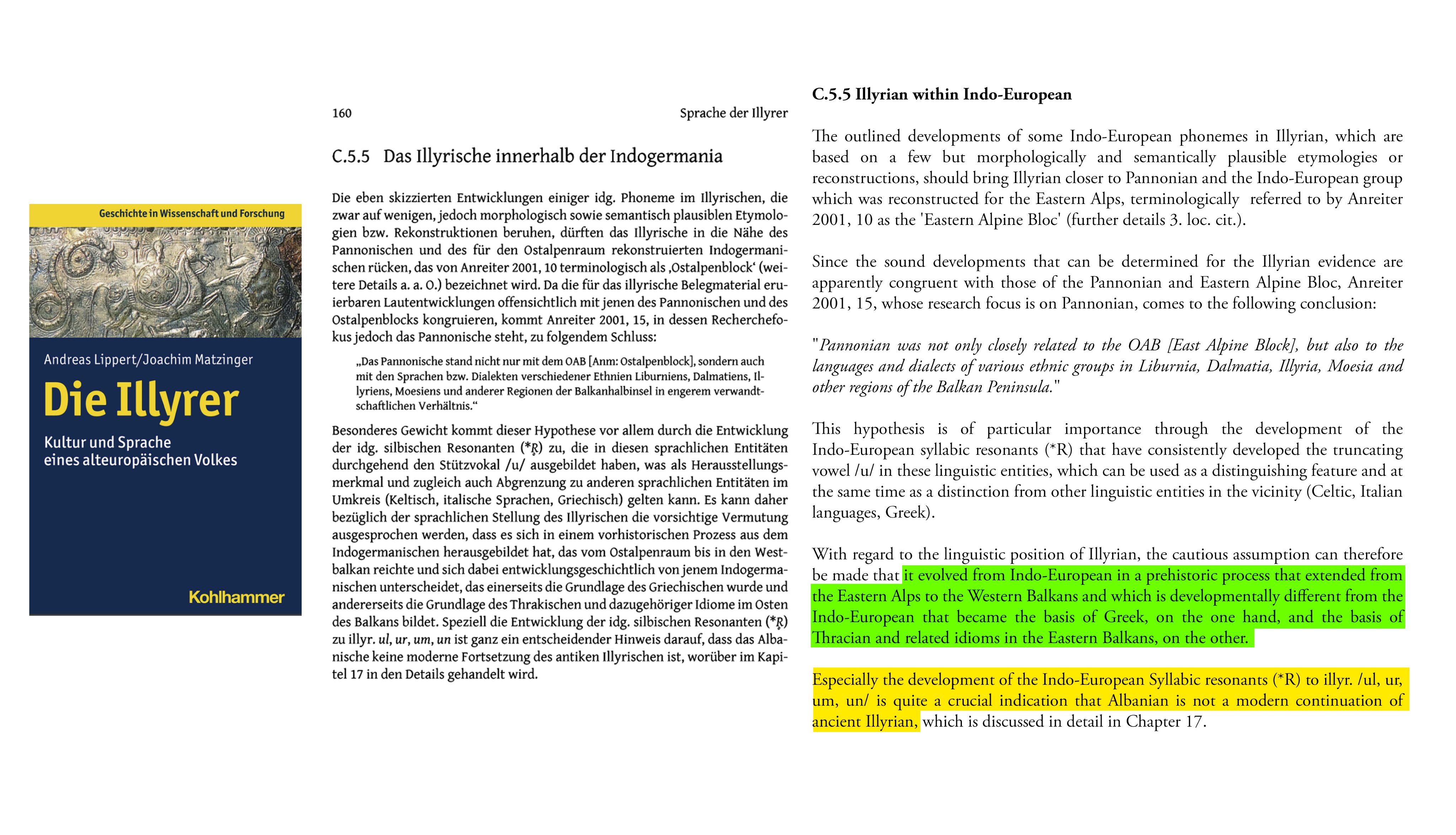Although it is widely believed that Albanian goes back to Illyrian or even Thracian, this view cannot be seriously upheld from the linguistic point of view (see Matzinger 2009). None of the ancient personal or local names ascribed to Illyrian are continued in Albanian without interruption (e.g. the place-name Shkodra is merely a loan from Latin Scodra). Consequently, Albanian cannot be regarded as an offspring of Illyrian or even Thracian but must be considered to be a modern continuation of some other undocumented Indo-European Balkan idiom. However, Albanian is closely related to Illyrian and also Messapic (a language spoken in Southern Italy in antiquity but originally of Balkan origin), which is why Albanian in some instances may shed some light on the explanation of Messapic as well as Illyrian words (see Matzinger 2005): (Messapic-) Oenotrian ῥινός ‘clouds’ ~ Old Geg rẽ, Old Tosk rē ‘cloud’, the Messapic gloss βρένδο- ‘stag’ and the place-name Brundisium (Italian Bríndisi) ~ Old Geg brĩ, or the name of the Illyrian tribe of the Taulantioi ~ Albanian dallëndyshe ‘swallow’ (see Eichner 2004: 10 f.).
Albanian shares a considerable number of words in common with Rumanian (see Solta 1980: 3 f., 125 f. and Vătăşescu 1997). Some of them are remnants of an old inherited vocabulary (e.g. Albanian thark ‘pen for young livestock’ ~ Rumanian ţarc ‘id.’), while others comprise a younger category of Latin words attested in some cases only in Albanian and Rumanian (e.g. Albanian mëngon ‘get up very early’ ~ Rumanian mâneca ‘id.’ ← Latin *mānicāre ‘id.’). Both classes emerged from old and intensive contacts between the Proto-Albanians and the ancestors of the Rumanians. A widespread opinion regards the older category of the Albano-Rumanian common lexicon as the reflex of an ancient substratum of Thracian, Dacian, or unknown origin (a collection of these words is Brâncuş 1983). Aside from a few single words of perhaps non-Indo-European origin (Albanian modhullë ‘yellow vetchling [Lathyrus aphaca]’ ~ Rumanian mazăre ‘pea’), the largest part of this alleged substratum common to both Albanian and Rumanian consists simply of loan-words in Rumanian from Proto-Albanian, e.g. Rumanian ţarc ‘pen for young livestock’ from Proto-Albanian */tsárka-/ (Modern Albanian thark). The derivational base of this noun is continued in the Old Albanian verb thurën ‘interweave’ (< IE */k̑erH-/ ‘weave’, cf. Latin crātis ‘pen’; see details in Schumacher 2009: 43−45).
It is a characteristic feature of the Albanian language to be open to loan-words from various sources. The oldest stratum is found in Ancient Greek loans, which result from contacts between Greeks and speakers of Proto-Albanian from about 600 BCE onward. Subsequent to the Roman occupation of the Balkans, Proto-Albanian was heavily influenced by Latin. Single words as well as a good many derivational suffixes were taken over. The Greek loan-words are of various chonological origins. The oldest are of Ancient Greek (Doric) provenance, mostly designations of vegetables, spices, fruits, animals, and tools (cf. Old Geg drapënë, modern Albanian drapër ‘sickle’ ← δρέπανον ‘id.’, Old Geg lakënë, modern Albanian lakër ‘cabbage’ ← λάχανον ‘potherbs’, presh ‘leek’ ← πράσον ‘id.’). These loans resulted from the earliest contacts between Greeks − either colonists of the Adriatic coastal regions or more probably Greek merchants in the Balkan hinterland − and Proto-Albanians from the 8th century BCE on.






